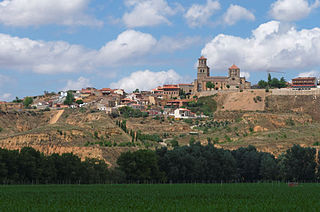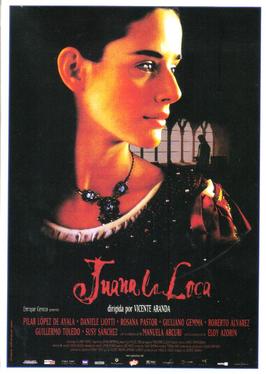
Valladolid is a municipality in Spain and the primary seat of government and de facto capital of the autonomous community of Castile and León. It is also the capital of the province of Valladolid. It has a population of 300,618 people.

Joanna, historically known as Joanna the Mad, was the nominal queen of Castile from 1504 and queen of Aragon from 1516 to her death in 1555. She was the daughter of Queen Isabella I of Castile and King Ferdinand II of Aragon. Joanna was married by arrangement to the Austrian archduke Philip the Handsome on 20 October 1496. Following the deaths of her elder brother John, elder sister Isabella, and nephew Miguel between 1497 and 1500, Joanna became the heir presumptive to the crowns of Castile and Aragon. When her mother died in 1504, she became queen of Castile. Her father proclaimed himself governor and administrator of Castile.

Joanna of Castile, known as la Beltraneja, was a claimant to the throne of Castile, and Queen of Portugal as the wife of King Afonso V, her uncle.

The Royal Palace of Madrid is the official residence of the Spanish royal family at the city of Madrid, although now used only for state ceremonies. The palace has 135,000 m2 (1,450,000 sq ft) of floor space and contains 3,418 rooms. It is the largest royal palace in Europe.

The Royal Sites are a set of palaces, monasteries, and convents built for and under the patronage of the Spanish monarchy. They are administered by Patrimonio Nacional (National Heritage), a Spanish state agency; most are open to the public, at least in part, except when they are needed for state or official events.

Joanna of Austria was Princess of Portugal by marriage to João Manuel, Prince of Portugal. She served as regent of Spain for her brother Philip II during his trips to England to marry Mary I from 1554 to 1556, and 1556 to 1559. She was the mother of King Sebastian of Portugal.

Tordesillas is a town and municipality in the province of Valladolid, Castile and León, central Spain. It is located 25 kilometres (16 mi) southwest of the provincial capital, Valladolid at an elevation of 704 metres (2,310 ft). The population was c. 8,760 as of 2021.

Toro is a town and municipality in the province of Zamora, part of the autonomous community of Castile and León, Spain. It is located on a fertile high plain, northwest of Madrid at an elevation of 740 metres (2,430 ft).

The Crown of Castile was a medieval polity in the Iberian Peninsula that formed in 1230 as a result of the third and definitive union of the crowns and, some decades later, the parliaments of the kingdoms of Castile and León upon the accession of the then Castilian king, Ferdinand III, to the vacant Leonese throne. It continued to exist as a separate entity after the personal union in 1469 of the crowns of Castile and Aragon with the marriage of the Catholic Monarchs up to the promulgation of the Nueva Planta decrees by Philip V in 1716.

Mad Love is a 2001 period drama film written and directed by Vicente Aranda starring Pilar López de Ayala and Daniele Liotti. The plot follows the tragic fate of Queen Joanna of Castile, madly in love with an unfaithful husband, Philip the Handsome, Archduke of Austria. It is one of the several adaptations of Manuel Tamayo y Baus' 1855 historic drama The Madness of Love.

Ventura Rodríguez Tizón was a Spanish architect and artist. Born at Ciempozuelos, Rodríguez was the son of a bricklayer. In 1727, he collaborated with his father in the work at the Royal Palace of Aranjuez.

Ferdinand II, called Ferdinand the Catholic, was King of Aragon from 1479 until his death in 1516. As the husband and co-ruler of Queen Isabella I of Castile, he was also King of Castile from 1475 to 1504. He reigned jointly with Isabella over a dynastically unified Spain; together they are known as the Catholic Monarchs. Ferdinand is considered the de facto first king of Spain, and was described as such during his reign, even though, legally, Castile and Aragon remained two separate kingdoms until they were formally united by the Nueva Planta decrees issued between 1707 and 1716.

The Royal Alcázar of Madrid was a fortress located at the site of today's Royal Palace of Madrid, Madrid, Spain. The structure was originally built in the second half of the ninth century by the Muslims, then extended and enlarged over the centuries, particularly after 1560. It was at this time that the fortress was converted into a royal palace, and Madrid became the capital of the Spanish Empire. Despite being a palace, the great building kept its original Arabic title of Alcázar.

Isabella I, also called Isabella the Catholic, was Queen of Castile and León from 1474 until her death in 1504. She was also Queen of Aragon from 1479 until her death as the wife of King Ferdinand II. Reigning together over a dynastically unified Spain, Isabella and Ferdinand are known as the Catholic Monarchs.

Hernando de Talavera, O.S.H. was a Spanish clergyman and councilor to Queen Isabel of Castile. He began his career as a monk of the Order of Saint Jerome, was appointed the queen's confessor and with her support and patronage, became the Archbishop of Granada.

The Archiepiscopal Palace of Alcalá de Henares is a palace located in Alcalá de Henares, in the Community of Madrid, Spain. It is now home to the Diocese of Alcalá de Henares. It is located in the Plaza del Palacio and this form part of the monumental set declared World Heritage Site by UNESCO.
The Royal Household and Heritage of the Crown of Spain was the institution of the Monarchy of Spain. It governed the organization of the Royal Spanish Court from the time of the Habsburg dynasty, which introduced the so-called Burgundian etiquette, up to the reign of King Alfonso XIII, great-grandfather of the current King Felipe VI, in all that regarded the structure of the Court as well as the ceremonial matters, etiquette and protocol.

Alfonso de Castilla y Molina was a Spanish noble in the service of the Kingdom of Castile. He was an Infante de Castilla, son of King Sancho IV de Castilla, King of Castile and of his wife, the Queen María de Molina.

La Loca, also known as Juana la Loca, is an opera by Gian Carlo Menotti, composed in 1979. It is a romantic drama about the life of Joanna of Castile (1479–1555). It was written as a vehicle for soprano Beverly Sills and received its premiere on June 3, 1979, at the San Diego Opera, followed by the New York City Opera. Critical response was largely negative, so Menotti completely reworked it. The revised version premiered in 1982 at the Festival of Two Worlds in Spoleto, Italy. The American premiere of the revised version took place at the Spoleto Festival USA in Charleston, South Carolina, on June 1, 1984.

Juan de Talavera was a Spanish architect, sculptor and carver, member of the "Toledo School of Architecture", and architect of Queen Isabella I of Castile. Probably his father was also named Juan de Talavera, and he was a nephew of Andrés de Talavera, both working in the Cathedral of Seville circa 1450. Juan de Talavera married Maria Gutierrez, daughter of Egas Coeman or Egas of Brussels and he was probably also a nephew of Juan Guas by his wife.






















